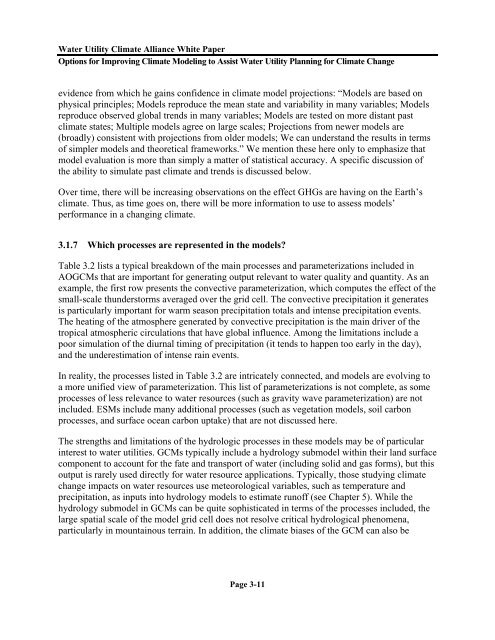Options for Improving Climate Modeling to Assist Water Utility ...
Options for Improving Climate Modeling to Assist Water Utility ...
Options for Improving Climate Modeling to Assist Water Utility ...
Create successful ePaper yourself
Turn your PDF publications into a flip-book with our unique Google optimized e-Paper software.
<strong>Water</strong> <strong>Utility</strong> <strong>Climate</strong> Alliance White Paper<br />
<strong>Options</strong> <strong>for</strong> <strong>Improving</strong> <strong>Climate</strong> <strong>Modeling</strong> <strong>to</strong> <strong>Assist</strong> <strong>Water</strong> <strong>Utility</strong> Planning <strong>for</strong> <strong>Climate</strong> Change<br />
evidence from which he gains confidence in climate model projections: “Models are based on<br />
physical principles; Models reproduce the mean state and variability in many variables; Models<br />
reproduce observed global trends in many variables; Models are tested on more distant past<br />
climate states; Multiple models agree on large scales; Projections from newer models are<br />
(broadly) consistent with projections from older models; We can understand the results in terms<br />
of simpler models and theoretical frameworks.” We mention these here only <strong>to</strong> emphasize that<br />
model evaluation is more than simply a matter of statistical accuracy. A specific discussion of<br />
the ability <strong>to</strong> simulate past climate and trends is discussed below.<br />
Over time, there will be increasing observations on the effect GHGs are having on the Earth’s<br />
climate. Thus, as time goes on, there will be more in<strong>for</strong>mation <strong>to</strong> use <strong>to</strong> assess models’<br />
per<strong>for</strong>mance in a changing climate.<br />
3.1.7 Which processes are represented in the models?<br />
Table 3.2 lists a typical breakdown of the main processes and parameterizations included in<br />
AOGCMs that are important <strong>for</strong> generating output relevant <strong>to</strong> water quality and quantity. As an<br />
example, the first row presents the convective parameterization, which computes the effect of the<br />
small-scale thunders<strong>to</strong>rms averaged over the grid cell. The convective precipitation it generates<br />
is particularly important <strong>for</strong> warm season precipitation <strong>to</strong>tals and intense precipitation events.<br />
The heating of the atmosphere generated by convective precipitation is the main driver of the<br />
tropical atmospheric circulations that have global influence. Among the limitations include a<br />
poor simulation of the diurnal timing of precipitation (it tends <strong>to</strong> happen <strong>to</strong>o early in the day),<br />
and the underestimation of intense rain events.<br />
In reality, the processes listed in Table 3.2 are intricately connected, and models are evolving <strong>to</strong><br />
a more unified view of parameterization. This list of parameterizations is not complete, as some<br />
processes of less relevance <strong>to</strong> water resources (such as gravity wave parameterization) are not<br />
included. ESMs include many additional processes (such as vegetation models, soil carbon<br />
processes, and surface ocean carbon uptake) that are not discussed here.<br />
The strengths and limitations of the hydrologic processes in these models may be of particular<br />
interest <strong>to</strong> water utilities. GCMs typically include a hydrology submodel within their land surface<br />
component <strong>to</strong> account <strong>for</strong> the fate and transport of water (including solid and gas <strong>for</strong>ms), but this<br />
output is rarely used directly <strong>for</strong> water resource applications. Typically, those studying climate<br />
change impacts on water resources use meteorological variables, such as temperature and<br />
precipitation, as inputs in<strong>to</strong> hydrology models <strong>to</strong> estimate runoff (see Chapter 5). While the<br />
hydrology submodel in GCMs can be quite sophisticated in terms of the processes included, the<br />
large spatial scale of the model grid cell does not resolve critical hydrological phenomena,<br />
particularly in mountainous terrain. In addition, the climate biases of the GCM can also be<br />
Page 3-11

















